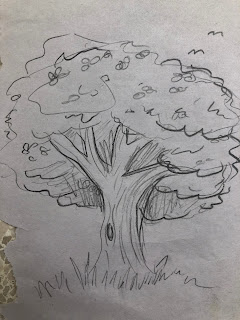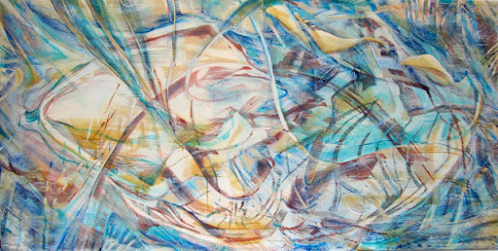Rachel Van Egmond: Representation: What Does it Take?
Representation: What Does it Take?
We all have our own way to represent things, and imagery stirs different reactions in different people.
So how are we able to visually communicate?
The language we use to portray things often means more than the image itself.
Warm Breeze, Mixed Media Collage , 21.75 x 21.5 inches
Nancy Newton
Topaz Lake, Acrylic on canvas; 3 x 4 ft
Rachel Van Egmond
In response to Nancy Newton’s work, I wanted to discuss the idea of representational art. My own work is quite representational, and I am not often drawn to abstract work. However, I think there is a lot to be said for the innate feelings that abstract can draw out, where objective portrayals cannot. I think the two examples above show that clearly. The goal of my work was purely a test of technical skill. I wanted to see how photorealistic I could work on a large scale- and I think I succeeded. Despite reaching this goal, I find the piece quite sterile. It only shows a pretty scene, with no emotional connection or artistic liberty. Nancy’s work is absolutely filled with emotion, passion, and movement. Even the titles betray the different sensations. While mine is simply a location, her work is titled ”Warm Breeze”. Looking at the collage, it's almost like I can feel it. The spontaneity and layering is beautiful. Although not traditionally representational, it definitely represents not only an object, but a feeling.
So what does all this say about representational art? This is not all to say that it is rigid and stale, and we all need to throw realism out the window. I think this exercise of comparison is just helpful to think about intention in art, and how we communicate in our artistic languages. We need to know how stylistic choices will impact the viewer, so that we can be sure we are touching them in the way we want to. With a confident knowledge of technical skill, we can pick and choose what principles we are concerned with, and what we are willing to let slide. Nancy’s work is a beautiful example of an artist’s eye drafting a work that feels intentional and playful. It is inspiring work that encourages me to loosen up, with the confidence that the end result can still be something amazing.
This exploration led me to wonder about our internal perceptions, and how I could study representational work to make connections. I theorized that if I asked random people to draw a tree that they would see as "good" and a tree that they would look at and think it is "bad", I could find patterns. I hoped that by doing this, I could navigate the natural visual languages we all subconsciously subscribe to.
 |
| "Good" Tree |
 |
| "Bad" Tree |
 |
| "Good" Tree |
 |
| "Bad" Tree |
 |
| "Good" Tree |
 |
| "Good" Tree |
 |
| "Bad" Tree |
 |
| "Good" Tree |
 |
| "Bad" Tree |
 |
| "Good" Tree |
 |
| "Bad" Tree |
 |
| "Bad" Tree |
I think that my little experiment was a success, and I came out of it with a couple major observations.
First, people commonly opted for a fuller, softer tree to be "good". The bad trees were often pointy and unwelcoming, with jagged and straight lines being popular. This highlights the idea of this unspoken visual language. Working to understand connections between what could be seen as arbitrary choices and peoples feelings is super important for successful abstract art. Nancy shows an understanding of this in her work by pairing comfortable shapes and colours with bolder choices. This creates dynamic works that prompt viewers to dig deeper and think longer.
My second significant observation was the contrasting amounts of detail for either prompts. Across the board, people saw more detail as good, and low effort and simple lines as being fitting for a "bad" tree. This interestingly mirrors how we naturally feel. Those who "put the effort in" to look nice are perceived much more highly than those who could have just run out the door. I think there are many examples that could further emphasize this point that "good" things take more than those that are "worse". In art, people commonly link more detailed pieces to success, looking down on simpler designs. I definitely have been guilty of disregarding abstract art because it looks "easy", or just like not enough. I think Nancy Newton succeeds in her use of layering. Her work leaves the viewer satisfied. In this sense, it isn't the accurate representation that matters, but the amount of information given to the viewer. Taking the time to study what representation means, and how it impacts the viewer is crucial not just in works of realism. By exploring subconscious patterns, abstract work can say anything it pleases in an unique visual language.
After diving into Nancy's work and exploring visual communication, I feel inspired to introduce new freedoms into my own work.



